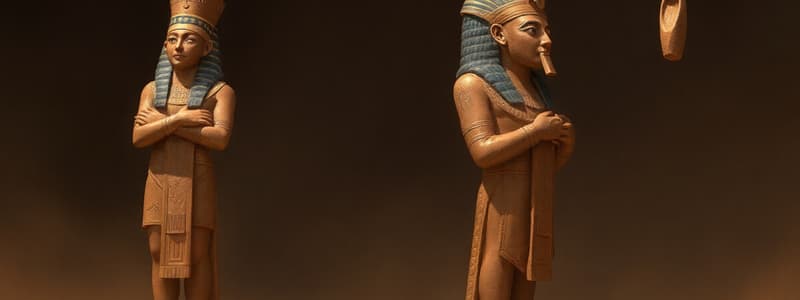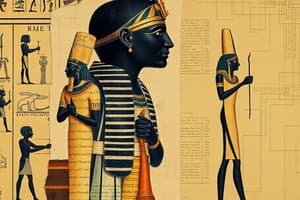Podcast
Questions and Answers
What does the size of the figures in ancient Egyptian art signify?
What does the size of the figures in ancient Egyptian art signify?
Which statement describes the order of the images in Egyptian art?
Which statement describes the order of the images in Egyptian art?
What defines raised relief in ancient Egyptian art?
What defines raised relief in ancient Egyptian art?
What was the purpose of squared grids used by ancient Egyptian artists?
What was the purpose of squared grids used by ancient Egyptian artists?
Signup and view all the answers
What type of relief involves figures that are cut away and higher than the background?
What type of relief involves figures that are cut away and higher than the background?
Signup and view all the answers
What characteristic sets wall painting apart from raised and sunk reliefs?
What characteristic sets wall painting apart from raised and sunk reliefs?
Signup and view all the answers
What is the significance of the three-dimensional representation in Egyptian art?
What is the significance of the three-dimensional representation in Egyptian art?
Signup and view all the answers
How did idealism influence representations in ancient Egyptian art?
How did idealism influence representations in ancient Egyptian art?
Signup and view all the answers
Which materials were used to create three-dimensional statues in ancient Egypt?
Which materials were used to create three-dimensional statues in ancient Egypt?
Signup and view all the answers
What is the common tendency behind the symbolism in ancient Egyptian artwork?
What is the common tendency behind the symbolism in ancient Egyptian artwork?
Signup and view all the answers
What is a characteristic of formal statues in ancient Egyptian art?
What is a characteristic of formal statues in ancient Egyptian art?
Signup and view all the answers
How was informal sculpture different from formal sculpture in ancient Egypt?
How was informal sculpture different from formal sculpture in ancient Egypt?
Signup and view all the answers
What is a defining feature of two-dimensional art in ancient Egyptian culture?
What is a defining feature of two-dimensional art in ancient Egyptian culture?
Signup and view all the answers
What was the intention behind using the scale or size effectively in ancient Egyptian art?
What was the intention behind using the scale or size effectively in ancient Egyptian art?
Signup and view all the answers
How were wooden statues constructed in ancient Egypt?
How were wooden statues constructed in ancient Egypt?
Signup and view all the answers
What differentiates a back pillar in three-dimensional statues?
What differentiates a back pillar in three-dimensional statues?
Signup and view all the answers
Study Notes
Ancient Egyptian Art Principles
- Egyptian art is differentiated through specific features
- These features introduce the style of art pieces
- Three-dimensional art is based on frontality.
- Statues face forward, whether standing, seated, or kneeling
Three-Dimensional Art Materials
- Statues are made of stone, wood, or metal
- Stone statues were carved from a single block of stone
- Gaps filled to protect from damage
- Usually, statues had a back pillar for support
- Wood statues were carved from multiple pieces joined together by tenons
- Metal statues were hammered into sheets, wrapped around a wooden form or using the lost wax method
Formal and Informal Statues
- Formal statues represent deities and kings, limited to poses like standing, sitting, or kneeling.
- Informal statues depicted other people like servants.
- Servants were positioned in tombs to serve the elite.
- Informal statues showed activities: bending or squatting
Two-Dimensional Representation
- The representation includes scenes, paintings, and reliefs on palettes and walls.
- Bodies are often shown in profile view.
- Parts like eyebrows, eyes, and shoulders are shown in full view,
- Social status is reflected in figure size; larger figures are more important.
- Kings and gods are larger than other figures.
Scale and Size
- Figure size reflects social status.
- Larger figures are more significant, representing higher social positions (e.g., kings or gods).
Hieroglyphs
- Hieroglyphs are small images, following two-dimensional principles in Egyptian art.
Depicting Items
- Items are presented from an easily recognizable viewpoint
Order of Images
- Images aren't haphazard, but follow ordered registers.
- A lower border of a register forms a ground line for figures.
Avoiding Idealism in Depictions
- Most depictions in Egyptian art show idealism.
- Exceptions exist for specific periods.
Symbolism
- Depicted items often symbolize more than their literal appearance.
Relief Types
- Reliefs include raised (high) and sunk (low) relief.
- Raised relief depicts figures protruding from the background.
- Sunk relief cuts away the background, leaving figures below the surface
Wall Painting Techniques
- Surfaces were prepared by smoothing
- Scenes were sketched in red (correction in black)
- Grids were used for precision
- Colors sourced from nature - white (gypsum or limestone), black (various forms of carbon)
- Men often depicted in reddish color, women in white.
Studying That Suits You
Use AI to generate personalized quizzes and flashcards to suit your learning preferences.
Related Documents
Description
Explore the distinctive features of Ancient Egyptian art, particularly focusing on three-dimensional sculptures. This quiz covers materials used for creating statues, their structural details, and the distinction between formal and informal representations in this historical art form. Test your knowledge on the unique stylistic choices of ancient artists.




